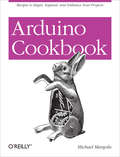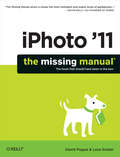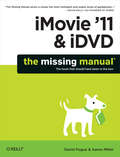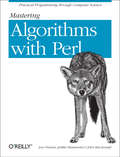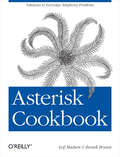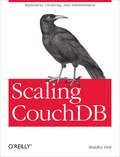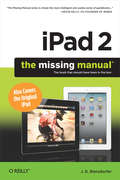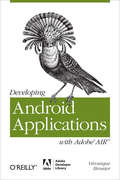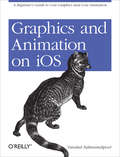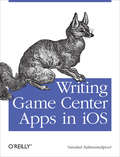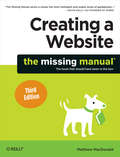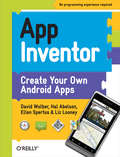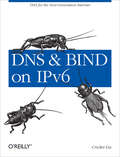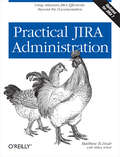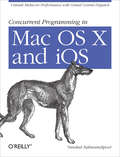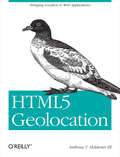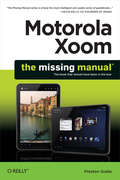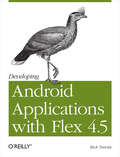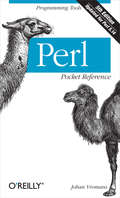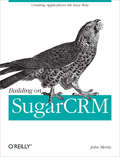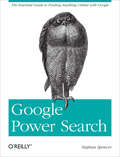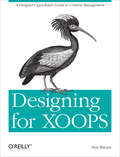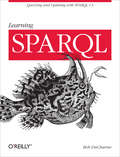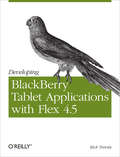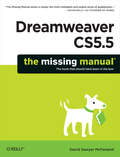- Table View
- List View
Arduino Cookbook (Oreilly And Associate Ser.)
by Michael MargolisCreate your own toys, remote controllers, alarms, detectors, robots, and many other projects with the Arduino device. This simple microcontroller board lets artists and designers build a variety of amazing objects and prototypes that interact with the physical world. With this cookbook you can dive right in and experiment with more than a hundred tips and techniques, no matter what your skill level is.The recipes in this book provide solutions for most common problems and questions Arduino users have, including everything from programming fundamentals to working with sensors, motors, lights, and sound, or communicating over wired and wireless networks. You'll find the examples and advice you need to begin, expand, and enhance your projects right away.Get to know the Arduino development environmentUnderstand the core elements of the Arduino programming languageUse common output devices for light, motion, and soundInteract with almost any device that has a remote controlLearn techniques for handling time delays and time measurementUse simple ways to transfer digital information from sensors to the Arduino deviceCreate complex projects that incorporate shields and external modulesUse and modify existing Arduino libraries, and learn how to create your own
iPhoto '11: The Missing Manual (The\missing Manual Ser.)
by David Pogue Lesa SniderWith better ways to get your photos online and new options for creating printed projects, iPhoto '11 makes it easier than ever to transfer photos from a digital camera, organize them, and publish, print, or share them in maps--but there's still no printed manual for the program. Fortunately, David Pogue and Lesa Snider team up in this witty, authoritative book that should have been in the box. Organize your collection. Discover all of the options for grouping your pictures--by events, in albums, or based on who's in the photo or where it was taken. Sharpen your editing skills. Learn how to use iPhoto's beefed-up editing options, including its Photoshop-like adjustments panel. Share images online. Get your photos to everyone on your list by publishing them to Flickr, Facebook, and MobileMe. Dive into creative projects. Have fun building slideshows (with music), gift books, calendars, and cards.
iMovie '11 & iDVD: The Missing Manual (The\missing Manual Ser.)
by David Pogue Aaron MillerApple's video-editing program is better than ever, but it still doesn't have a printed guide to help you get started. That's where this gorgeous, full-color book comes in. You get clear explanations of iMovie's impressive new features, like instant rendering, storyboarding, and one-step special effects. Experts David Pogue and Aaron Miller also give you a complete course in film editing and DVD design. Edit video like the pros. Import raw footage, add transitions, and use iMovie's newly restored, intuitive timeline editor. Create stunning trailers. Design Hollywood-style "Coming Attractions!" previews for your movies. Share your film. Distribute your movie in a variety of places--on smartphones, Apple TV, your own site, and with one-click exports to YouTube, Facebook, Vimeo, CNN iReport, and MobileMe. Make DVDs. Design the menus, titles, and layout for your DVDs, and burn them to disc.
Mastering Algorithms with Perl: Practical Programming Through Computer Science
by Jon Orwant Jarkko Hietaniemi John MacdonaldMany programmers would love to use Perl for projects that involve heavy lifting, but miss the many traditional algorithms that textbooks teach for other languages. Computer scientists have identified many techniques that a wide range of programs need, such as: Fuzzy pattern matching for text (identify misspellings!) Finding correlations in data Game-playing algorithms Predicting phenomena such as Web traffic Polynomial and spline fitting Using algorithms explained in this book, you too can carry out traditional programming tasks in a high-powered, efficient, easy-to-maintain manner with Perl. This book assumes a basic understanding of Perl syntax and functions, but not necessarily any background in computer science. The authors explain in a readable fashion the reasons for using various classic programming techniques, the kind of applications that use them, and -- most important -- how to code these algorithms in Perl. If you are an amateur programmer, this book will fill you in on the essential algorithms you need to solve problems like an expert. If you have already learned algorithms in other languages, you will be surprised at how much different (and often easier) it is to implement them in Perl. And yes, the book even has the obligatory fractal display program. There have been dozens of books on programming algorithms, some of them excellent, but never before has there been one that uses Perl. The authors include the editor of The Perl Journal and master librarian of CPAN; all are contributors to CPAN and have archived much of the code in this book there. "This book was so exciting I lost sleep reading it." Tom Christiansen
Asterisk Cookbook: Solutions to Everyday Telephony Problems
by Leif Madsen Russell BryantAsterisk has a wealth of features to help you customize your PBX to fill very specific business needs. This short cookbook offers recipes for tackling dialplan fundamentals, making and controlling calls, and monitoring channels in your PBX environment. Each recipe includes a simple code solution you can put to work immediately, along with a detailed discussion that offers insight into why and how the recipe works. This book focuses on Asterisk 1.8, although many of the conventions and information presented are version-agnostic. These recipes include solutions to help you: Authenticate callers before moving on in your dialplan Redirect calls received by your auto-attendant Create an automatic call-back service Initiate hot-desking to login to and accept calls at any office device Monitor and interrupt live calls to train new employees at a call center Record calls from your Asterisk dialplan
Scaling CouchDB: Replication, Clustering, and Administration
by Bradley HoltThis practical guide offers a short course on scaling CouchDB to meet the capacity needs of your distributed application. Through a series of scenario-based examples, this book lets you explore several methods for creating a system that can accommodate growth and meet expected demand. In the process, you learn about several tools that can help you with replication, load balancing, clustering, and load testing and monitoring. Apply performance tips for tuning your database Replicate data, using Futon and CouchDB's RESTful interface Distribute CouchDB's workload through load balancing Learn options for creating a cluster of CouchDB nodes, including BigCouch, Lounge, and Pillow Conduct distributed load testing with Tsung
iPad 2: The Missing Manual
by J. D. BiersdorferThe iPad is an amazing media device, once you really know how to use it. In this entertaining book, New York Times tech columnist and iPad expert Jude Biersdorfer shows you how to get the most out of this sleek tablet to surf the Web, send and receive email, watch movies and TV shows, read eBooks, listen to music, play games, and even do a little iWork. It's the book that should have been in the box.The important stuff you need to knowLearn undocumented tips and tricks. Get the lowdown on cool iPad secretsBuild and play your media library. Fill up your iPad with music, movies, TV shows, eBooks, photos, music videos, audiobooks, and podcastsGet online. Connect through Wi-Fi and Wi-Fi+3G—on both GSM and CDMA networksDiscover state-of-the-art e-reading. Buy and read books and magazines in full colorConsolidate your email accounts. Read email from your personal and work accountsShop iTunes and the App Store. Navigate Apple's media emporiums, and learn how to get free music, video, books, and apps
Developing Android Applications with Adobe AIR: An ActionScript Developer's Guide to Building Android Applications
by Véronique BrossierPut your ActionScript 3 skills to work building mobile apps. This book shows you how to develop native applications for Android-based smartphones and tablets from the ground up, using Adobe AIR. You learn the entire development process hands-on, from coding specific functions to options for getting your app published. Start by building a sample app with step-by-step instructions, using either Flash Professional or Flash Builder. Then learn how to use ActionScript libraries for typical device features, such as the camera and the accelerometer. This book includes ready-to-run example code and a case study that demonstrates how to bring all of the elements together into a full-scale working app. Create functionality and content that works on multiple Android devices Choose from several data storage options Create view and navigation components, including a back button Get tips for designing user experience with touch and gestures Build a location-aware app, or one that makes use of motion Explore ways to use audio, video, and photos in your application Learn best practices for asset management and development
Graphics and Animation on iOS: A Beginner's Guide to Core Graphics and Core Animation
by Vandad NahavandipoorJazz up your iPhone and iPad apps with some slick graphics and animation--and keep users from looking elsewhere. This short and concise book shows developers with even little Cocoa programming experience how to create impressive graphics and animation effects with relatively easy coding. Learn how to incorporate smooth animations and draw images in your apps to achieve the classy look you want. The recipes in this book include step-by-step instructions and simple code solutions that you can put to work right away. Learn basic concepts for adapting to different screen sizes Construct, set, and use colors Draw text, images, lines, and rectangles Add shadows to shapes Create and draw gradients Learn how to animate and scale, rotate, or move views
Writing Game Center Apps in iOS: Bringing Your Players Into the Game
by Vandad NahavandipoorNow that Apple has introduced the GameKit framework to its iOS SDK, you can integrate Game Center features directly into your iPhone and iPad apps. This concise cookbook shows you how it's done, with 18 targeted recipes for adding leaderboards, user authentication, achievements, multiplayer games, and many other features. How do you display players' scores and achievements? How do you create Game Center accounts and add friends? Each recipe in this book includes a simple code solution you can put to work immediately, along with a detailed discussion that offers insight into why and how the recipe works. Recipes include techniques to: Set up Game Center for an iOS App Use block objects and Grand Central Dispatch to write Game Center apps Authenticate a local player in Game Center Use iTunes Connect to create leaderboards and achievements Retrieve leaderboard and achievement information programmatically Handle players' state changes in multiplayer games
Creating a Website: The Missing Manual
by Matthew MacdonaldThink you need an army of skilled programmers to build a website? Think again. With nothing more than an ordinary PC, some raw ambition, and this book, you’ll learn how to create and maintain a professional-looking, visitor-friendly site. This Missing Manual gives you all the tools, techniques, and expert advice you need.Plan your site. Create web pages by learning the basics of HTML and HTML5.Control page design with CSS. Format text, images, links, tables, and other elements.Attract visitors. Ensure that people can find your site through popular search engines.Build a community. Add forums, fresh content, and a feedback form to encourage repeat visits.Get smart. Use free tools to identify your site’s strengths and weaknesses.Create your own blog. Post your musings with a free blog-hosting service.Bring in cash. Host Google ads, sell Amazon’s wares, or push your own products.Add pizzazz. Include audio, video, interactive menus, and more.
App Inventor
by Hal Abelson David Wolber Ellen Spertus Liz LooneyYes, you can create your own apps for Android phones—and it's easy to do. This extraordinary book introduces App Inventor for Android, a powerful visual tool that lets anyone build apps for Android-based devices. Learn the basics of App Inventor with step-by-step instructions for more than a dozen fun projects, such as creating location-aware apps, data storage, and apps that include decision-making logic.The second half of the book features an Inventor's manual to help you understand the fundamentals of app building and computer science. App Inventor makes an excellent textbook for beginners and experienced developers alike.Design games and other apps with 2D graphics and animationCreate custom multi-media quizzes and study guidesCreate a custom tour of your city, school, or workplaceUse an Android phone to control a LEGO® MINDSTORMS® NXT robotBuild location-aware apps by working with your phone’s sensorsExplore apps that incorporate information from the WebLearn computer science as you build your apps
DNS and BIND on IPv6: DNS for the Next-Generation Internet
by Cricket LiuIf you're preparing to roll out IPv6 on your network, this concise book provides the essentials you need to support this protocol with DNS. You'll learn how DNS was extended to accommodate IPv6 addresses, and how you can configure a BIND name server to run on the network. This book also features methods for troubleshooting problems with IPv6 forward- and reverse-mapping, and techniques for helping islands of IPv6 clients communicate with IPv4 resources. Topics include: DNS and IPv6--Learn the structure and representation of IPv6 addresses, and the syntaxes of AAAA and PTR records in the ip6.arpa IPv6 reverse-mapping zone BIND on IPv6--Use IPv6 addresses and networks in ACLs, and register and delegate to IPv6-speaking name servers Resolver Configuration--Configure popular stub resolvers (Linux/Unix, MacOS X, and Windows) to query IPv6-speaking name servers DNS64--Learn about the transition technology that allows clients with IPv6-only network stacks to communicate with IPv4 servers Troubleshooting--Use the nslookup and dig troubleshooting tools to look up the IPv6 addresses of a domain name, or reverse-map an IPv6 address to a domain name
Practical JIRA Administration: Using JIRA Effectively: Beyond the Documentation
by Matthew B. DoarIf you're familiar with JIRA for issue tracking, bug tracking, and other uses, you know it can sometimes be tricky to set up and manage. In this concise book, software toolsmith Matt Doar clarifies some of the more confusing aspects by answering difficult and frequently asked questions about JIRA administration. Practical JIRA Administration shows you how JIRA is intended to be used, making it an ideal supplement to the extensive documentation already available. The book's chapters are loosely connected, so you can go straight to the information that best serves your needs. Understand the difference between JIRA groups and JIRA project roles Discover what JIRA schemes do, and learn how to maintain them Use a consistent configuration approach to help you use JIRA as a platform Create a workflow from scratch Add, modify, and deactivate users Prepare for a JIRA upgrade, and troubleshoot if necessary Get remote access to JIRA via email, SQL, REST, and other methods
Concurrent Programming in Mac OS X and iOS: Unleash Multicore Performance with Grand Central Dispatch (Oreilly And Associate Ser.)
by Vandad NahavandipoorNow that multicore processors are coming to mobile devices, wouldn't it be great to take advantage of all those cores without having to manage threads? This concise book shows you how to use Apple's Grand Central Dispatch (GCD) to simplify programming on multicore iOS devices and Mac OS X. Managing your application's resources on more than one core isn't easy, but it's vital. Apps that use only one core in a multicore environment will slow to a crawl. If you know how to program with Cocoa or Cocoa Touch, this guide will get you started with GCD right away, with many examples to help you write high-performing multithreaded apps. Package your code as block objects and invoke them with GCD Understand dispatch queues--the pools of threads managed by GCD Use different methods for executing UI and non-UI tasks Create a group of tasks that GCD can run all at once Instruct GCD to execute tasks only once or after a delay Discover how to construct your own dispatch queues
HTML5 Geolocation: Bringing Location to Web Applications (Oreilly And Associate Ser.)
by Anthony T. Holdener IIITruly revolutionary: now you can write geolocation applications directly in the browser, rather than develop native apps for particular devices. This concise book demonstrates the W3C Geolocation API in action, with code and examples to help you build HTML5 apps using the "write once, deploy everywhere" model. Along the way, you get a crash course in geolocation, browser support, and ways to integrate the API with common geo tools like Google Maps. Learn how geo information is gathered from different sources, depending on the device Discover how coordinate systems work, including geodetic systems and datums Use the API to collect location information from a user's browser with JavaScript code Place geo information on a map using the Google Maps or ArcGIS JavaScript APIs Save geo data with databases, the Keyhole Markup Language, or the shapefile format Be familiar with several practical uses for geo data, such as geomarketing, geosocial, geotagging, and geo-applications
Motorola Xoom: The Missing Manual
by Preston GrallaMotorola Xoom is the first tablet to rival the iPad, and no wonder with all of the great features packed into this device. But learning how to use everything can be tricky--and Xoom doesn't come with a printed guide. That's where this Missing Manual comes in. Gadget expert Preston Gralla helps you master your Xoom with step-by-step instructions and clear explanations. As with all Missing Manuals, this book offers refreshing, jargon-free prose and informative illustrations. Use your Xoom as an e-book reader, music player, camcorder, and phone Keep in touch with email, video and text chat, and social networking apps Get the hottest Android apps and games on the market Do some work with Google Docs, Microsoft Office, or by connecting to a corporate network Tackle power-user tricks, such as barcode scanning, voice commands, and creating a Wi-Fi hotspot Sync your Xoom with a PC or a Mac
Developing Android Applications with Flex 4.5: Building Android Applications with ActionScript
by Rich TretolaReady to put your ActionScript 3 skills to work on mobile apps? This hands-on book walks you through the process of creating an Adobe AIR application from start to finish, using the Flex 4.5 framework. Move quickly from a basic Hello World application to complex interactions with Android APIs, and get complete code examples for working with Android device components--GPS, camera, gallery, accelerometer, multitouch display, and OS interactions. No matter how much Flex experience you have, this book is the ideal resource. Use Flash Builder 4.5 to create and debug a Flex Mobile project Choose a layout option to determine which files Flash Builder auto-generates Select permissions that control which devices can install your app from the Android Market Explore APIs that enable your app to interact with specific Android OS features Learn how to read and write text files, browse the file system for media files, and create and write to an SQLite database Use the URLRequest class to open your app in the browser, place calls, and create emails and text messages Load web and video content into your app with StageWebView Publish your app to an Android installer file with Flash Builder
Perl Pocket Reference: Programming Tools (Pocket Reference (o'reilly) Ser.)
by Johan VromansIf you have a Perl programming question, you'll find the answer quickly in this handy, easy-to-use quick reference. The Perl Pocket Reference condenses and organizes stacks of documentation down to the most essential facts, so you can find what you need in a heartbeat.Updated for Perl 5.14, the 5th edition provides a summary of Perl syntax rules and a complete list of operators, built-in functions, and other features. It's the perfect companion to O'Reilly's authoritative and in-depth Perl programming books, including Learning Perl, Programming Perl, and the Perl Cookbook..
Building on SugarCRM: Creating Applications the Easy Way
by John MerticIn the crowded field of customer relationship management (CRM) systems, SugarCRM stands out--not only for its modular design, but also for the ease with which you can develop, customize, and extend your CRM applications. This concise book provides a thorough overview of the development tools and APIs available in SugarCRM 6.2, showing both developers and nondevelopers alike how to use them to build a sample application step-by-step. You'll learn how to bend and twist SugarCRM's extensible MVC framework to create custom applications, including solutions for automating your business that go beyond traditional CRMs. Learn how SugarCRM modules interact with one another through data relationships Build your CRM application with SugarCRM's GUI developer tools--without touching code Use built-in design templates with Module Builder to design new CRM modules Customize modules with the Studio tool to add new fields or additional relationships between modules Automate common and tedious tasks within your application, using custom PHP code with SugarCRM's powerful API Integrate external applications into your CRM solution through SugarCRM's web services API
Google Power Search: The Essential Guide to Finding Anything Online with Google (Oreilly And Associate Ser.)
by Stephan SpencerBehind Google's deceptively simple interface is immense power for both market and competitive research--if you know how to use it well. Sure, basic searches are easy, but complex searches require specialized skills. This concise book takes you through the full range of Google's powerful search-refinement features, so you can quickly find the specific information you need. Learn techniques ranging from simple Boolean logic to URL parameters and other advanced tools, and see how they're applied to real-world market research examples. Incorporate advanced search operators such as filetype:, intitle:, daterange:, and others into your queries Use Google filtering tools, including Search Within Results, Similar Pages, and SafeSearch, among others Explore the breadth of Google through auxiliary search services like Google News, Google Books, Google Blog Search, and Google Scholar Acquire advanced Google skills that result in more effective search engine optimization (SEO)
Designing for XOOPS: A Designer's Quickstart Guide to Content Management
by Sun RuoyuLearn how to customize websites with XOOPS, the open source CMS that helps non-developers build dynamic community websites, intranets, and other applications. This concise book shows you how to use XOOPS themes and modules to design everything from simple blogs to large database-driven CMS portals. Web designers and current XOOPS users will learn how to create a site theme with CSS and jQuery libraries, including techniques for making additional modules conform to the site's look and feel. Although XOOPS uses the PHP-based Smarty templating system, all you need is a bit of XHTML and CSS experience to get started. Learn the workflow for turning an idea into a full-featured website Become familiar with XOOPS' theme-building tools, and set up PHP and MySQL environments Port an existing XHTML template to XOOPS Create themes with the 960 Grid System to save time and reduce code Use jQuery-based UI libraries to achieve complex effects Blend new modules into your theme with the template override function Go beyond traditional block layouts to customize your homepage
Learning SPARQL
by Bob DuCharmeGet hands-on experience with SPARQL, the RDF query language that's become a key component of the semantic web. With this concise book, you will learn how to use the latest version of this W3C standard to retrieve and manipulate the increasing amount of public and private data available via SPARQL endpoints. Several open source and commercial tools already support SPARQL, and this introduction gets you started right away.Begin with how to write and run simple SPARQL 1.1 queries, then dive into the language's powerful features and capabilities for manipulating the data you retrieve. Learn what you need to know to add to, update, and delete data in RDF datasets, and give web applications access to this data.Understand SPARQL’s connection with RDF, the semantic web, and related specificationsQuery and combine data from local and remote sourcesCopy, convert, and create new RDF dataLearn how datatype metadata, standardized functions, and extension functions contribute to your queriesIncorporate SPARQL queries into web-based applications
Developing BlackBerry Tablet Applications with Flex 4.5
by Rich TretolaReady to put your ActionScript 3 skills to work on mobile apps? This hands-on book walks you through the process of creating an Adobe AIR application for Blackberry Tablets from start to finish, using the Flex 4.5 framework. Move quickly from a basic Hello World application to complex interactions with Blackberry APIs, and get complete code examples for working with tablet components--including the accelerometer, GPS unit, camera, file system, and multitouch screen. This is an ideal resource no matter how much Flex experience you have. Use Flash Builder 4.5 to create and debug a Flex Mobile project Choose a layout option to determine which files Flash Builder autogenerates Obtain permissions you need to install your app on a Blackberry Tablet Read and write text files, browse the file system for media files, and create and write to an SQLite database Learn how to use native qnx components within your application Publish your app to a BlackBerry installer file with Flash Builder
Dreamweaver CS5.5: The Missing Manual (Missing Manual)
by David Sawyer McfarlandDreamweaver is the tool most widely used for designing and managing professional-looking websites, but it's a complex program. That's where Dreamweaver CS5.5: The Missing Manual comes in. With its jargon-free explanations, 13 hands-on tutorials, and savvy advice from Dreamweaver expert Dave McFarland, you'll master this versatile program with ease. Get A to Z guidance. Go from building your first web page to creating interactive, database-driven sites. Build skills as you learn. Apply your knowledge through tutorials and downloadable practice files. Create a state-of-the-art website. Use powerful, easy-to-use tools such as CSS3 and Spry effects to build visually rich, fast-loading pages. Add instant interactivity. Choose from pre-packaged JavaScript programs to add drop-down menus, tabbed panels, forms, and other features. Tap into databases. Connect your site to a database and build pages that dynamically sort and display stored information. Go mobile. Build and preview websites for smartphones and tablets. Discover hidden tips and tricks. Get undocumented workarounds and shortcuts.
